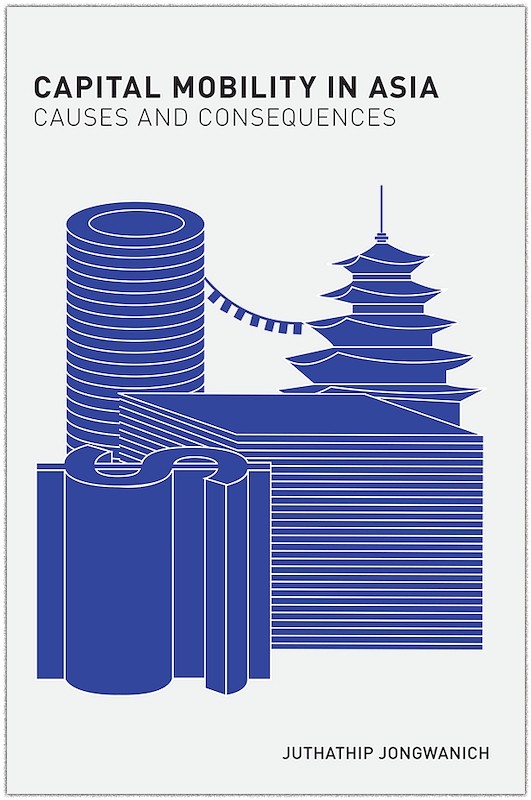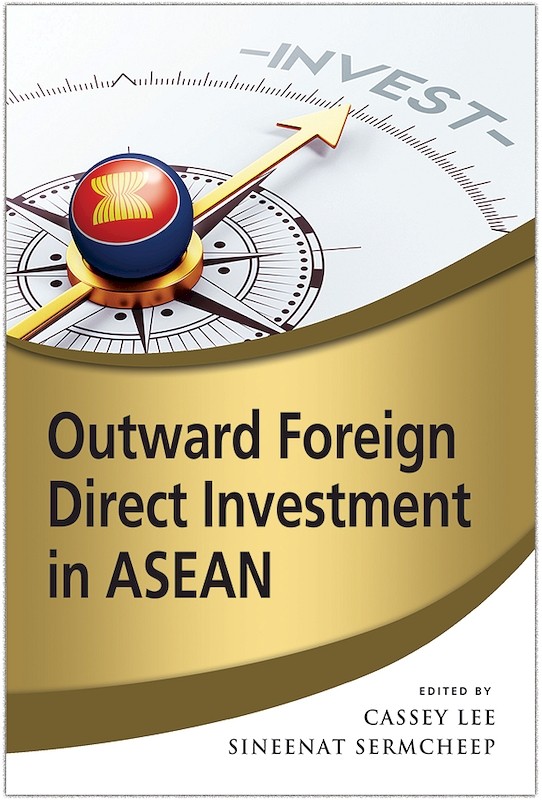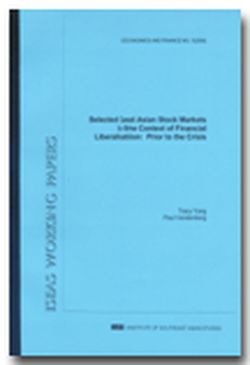Capital Mobility in Asia: Causes and Consequences

Juthathip Jongwanich, author
Date of publication:
2017
Publisher:
ISEAS – Yusof Ishak Institute
Number of pages:
232
Code:
BM551
Soft Cover
ISBN: 9789814786065
Reviews
Wishnu Mahraddika, Asian Pacific Economic Literature, 2018.
Asia is known as the region with the most vibrant economic progress. From 1980 through to the Asian crisis in 1997-98, the average growth rate of emerging and developing economies in Asia was around 7 per cent, much higher than other regions. From 2000 until 2016, the average growth rate returned to 7 per cent, including periods of double-digit growth such as 2006-7. With such dynamics, the region attracts various types of capital flows. Juthathip Jongwanich, one of Thailand's leading economic researchers, who specialises in the field of international economics, recently published a book that offers a comprehensive discussion on the determinants of capital mobility in Asia.
The author's intention in writing this book is to augment the literature on capital mobility in Asia, especially in the post-crisis period after 1997-98. By analysing data from selected countries in the region, Jongwanich (2017) explores several topics related to capital flows: (1) identifying crucial factors affecting capital flows. (2) reviewing the impact of capital flows on the domestic economy, especially on the real exchange rate, and (3) evaluating the effectiveness of policies designed to manage capital flows that were implemented in several countries in Asia.
This book has a lot to offer. The content is very relevant for academics, students, policy-makers, and government officials who are interested in the dynamics of capital flows in Asia, especially after the global financial crisis in 2008. In addition to using the latest data, the author also provides policy insights into using breakthrough approaches such as elaborating M&A data as well as setting up a capital policy index for Malaysia and Thailand. Another notable feature of the book is the separation of the analysis for inward and outward flows, which have different characteristics. Although the book already covers a significant amount of ground on this topic with novel approaches, it would be beneficial to include policy recommendations for particular countries, since the countries used in the regression analysis have different characteristics.
In the methodological area, considering the variety of metrics used in the regression analysis, the standardized beta approach to sort out which variable has the larger role in determining the flow could be applied in order to set the policy priorities. Lastly, on the chapter discussing capital account policy, the author claims that Malaysia's policy in controlling outflows is considered as effective. However, quoting one of the propositions about capital flows policy from Reinhart (2003:233), 'Controls in one market may shift volatility to other markets', there is a possibility that outflows could still occur through imports, which were not evaluated in the VAR.
"It has already been three decades since the emerging economies in Asia opened their capital account. The period is long enough to collect data for analyzing the behavior and the impact of capital flows in these economies. The author of this book provides this valuable service by carefully conducting empirical research on the subject and collating the findings in 8 chapters on the determinants, the impact, and the policy effects of capital flows.
... the author carries out empirical research on the various aspects of capital flows in EAEs during 1990 to 2014 and reports the results in eight independent chapters. The first two chapters describe trends and patterns of capital flows in the Asian region. Chapters 3 to 5 are on the determinants of capital flows classified by type: FDI versus non-FDI (foreign portfolio investment and others) and capital inflows versus capital outflows. Chapter 6 studies the effects of capital flows on real exchange rates. Chapter 7 simulates the effects of capital control policies on the volume and composition of capital flows in selected Asian counties. The last chapter summarizes the results and uses them to suggest policies. The study on the determinants and the effects of capital flow relies on various forms of regression specification and technique.
All of the above reviewed chapters are well-organized, well-written, and easy to read. Each can be a stand-alone article worthwhile for publication in leading academic journals. Overall, the book is strongly recommended for researchers, students, policy makers, and economic analysts who wish to understand and look for accessible tools for projecting the trends of capital inflows, capital outflows, real exchange rates, and capital account policy efficacy in developing countries."
About the publication
"Asia has benefitted greatly from its integration into the world economy. But globalization has its challenges, including those that are the subject of this excellent new study: how to manage the interface with global capital markets, especially in the current, highly unusual monetary policy settings in the major economies. Dr Juthathip Jongwanich has been researching these issues for several years. In this volume she writes with great authority, providing a comprehensively, succinct and accessible examination of the many complex issues. A must-read volume for policymakers and academics alike."
Hal Hill, H.W. Arndt Professor of Southeast Asian Economies, Australian National University
"A very timely and excellent book on capital volatility. Jongwanich provides a superb analysis on the impact of capital flows on home country, exchange rates and the capital account policies. A very important book, especially for academia and policymakers."
Muhamad Chatib Basri, Former Finance Minister of Indonesia
"This timely book presents outstanding research on the determinants and effects of capital flows as well as the effectiveness of capital control policies in dealing with volatile capital flows in emerging Asian countries. It will be a useful and valuable reading for researchers and policymakers to understand the nature of cross-border capital movement and design the policies conducive to more stable and sustainable economic growth."
Jong-Wha Lee, Professor of Economics and Director of Asiatic Research Institute, Korea University
"This is an important book. Ever since the East Asian financial crisis, it has been recognized that emerging market economies are vulnerable to both excessive inflows of capital and sudden outflows. But up until now there have been few detailed empirical studies of this issue. This book looks at the key factors determining capital mobility, considers the impact of capital flows, especially on real exchange rates, and examines the possibility of effective capital controls. Jongwanich draws two key conclusions: shifting the mix of inflows towards FDI is possible and desirable, and well-functioning domestic financial markets are essential if capital inflows are to be well used."
David Vines, Professor of Economics and Fellow of Balliol College, University of Oxford
Contents
-
Capital Mobility in Asia: Causes and Consequences
[Whole Publication, ISBN: 9789814786072], by Juthathip Jongwanich, editor -
Preliminary pages
-
1. Introduction
-
2. Capital Mobility in Emerging Asian Countries
-
3. Determinants of Inward Foreign Direct Investment in Emerging Asian Countries
-
4. Determinants of Outward Foreign Direct Investment from Emerging Asia
-
5. Determinants of Non-Foreign Direct Investment Capital Flows
-
6. Capital Flows and Real Exchange Rates in Emerging Asian Countries
-
7. Effectiveness of Capital Controls: Evidence from Malaysia and Thailand
-
8. Conclusions and Policy Inferences
-
Appendix 1: A Chronology of Capital Account Policy in Malaysia, 1992–2010
-
Appendix 2: A Chronology of Capital Account Policy in Thailand, 1990–2010
-
Bibliography
-
Index
-
About the Author






